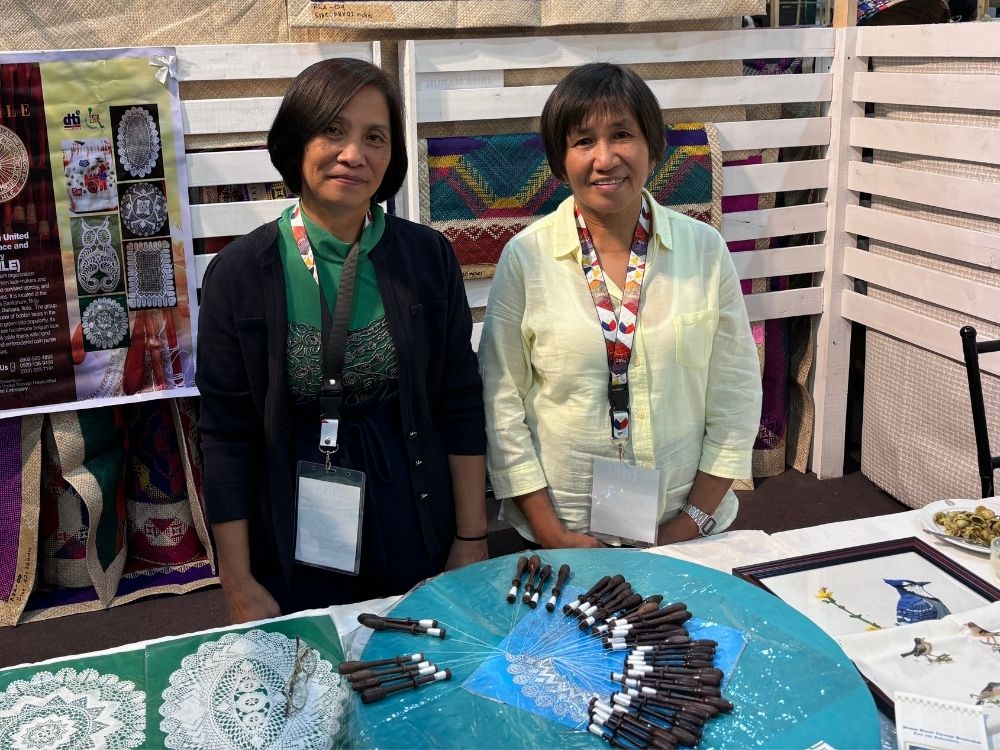A small and close-knit community of women in the small Iloilo town of Santa Barbara supports each other in health and in livelihood.
The Women United Through Handcrafted Lace and Embroidery (WUTHLE) helps Ilongga ex-Hansenites (people cured from leprosy) and their families learn the craft of lacemaking, which serves a dual purpose: a therapeutic hand exercise, and a viable source of income.
UNIQUELY UNITED
This all-female group of artisans from Santa Barbara have long been on top of their game as embroiderers and bobbin lacemakers.
Though these aren’t indigenous patterns or endemic textiles they’re making, the practice has metamorphosed into a cultural fabric that is unique to the women of this municipality in Iloilo.
The craftspeople are united by a common thread, as all are either a survivor of leprosy, or a close relative of one who learned the skill from a mission that started in 1985.
The women of WUTHLE were even dubbed as “the only Belgian lace makers in the entire Philippines” by a 2023 feature by the Department of Trade and Industry (DTI), paying homage to their weavers’ one-off talent and the equally unique and inspiring story behind the association’s establishment.
They make all sorts of embroidery and lace products, from traditional clothing like the barong, to ornamental textile pieces, to small items such as napkins and handkerchiefs.
MISSION-DRIVEN ORIGIN
WUTHLE’s establishment was an outcome of acts of generosity and a persistent advocacy.
It all started sometime in the 1980s, with the assignment of Sister Madeleine Dieryck, a Belgian missionary nun from the Missionary Sisters of the Immaculate Heart of Mary (ICM), at the leprosarium of the Western Visayas Sanitarium (now called the WVS and General Hospital).
There she worked for and among Hansenite patients, or those diagnosed with leprosy– a chronic infectious disease that affects the skin and the peripheral nerves. Hansen disease can cause permanent numbness and deformities, which, at that time, were deeply stigmatized in society.
In 1985, two young girls– both daughters of sanitarium patients Sr. Madeleine had worked with– showed appreciation by gifting her a hand-embroidered handkerchief.
“Bago magbakasyon si Sister Madeleine sa Belgium, she was given a token na handkerchief, tapos dun nag-start ang orders, and nalaman namin na pwede pala gawin itong livelihood,” shared bobbin lace maker and WUTHLE manager Susana ‘Suzzette’ Villan in an interview with GMA Regional TV News.
Amused by the hanky’s intricate details, Sr. Madeleine requested some more for their mission’s benefactors, eventually attracting patrons willing to shell out money for orders.
Not long after, more women from Santa Barbara– Hansenite patients, their mothers, and other interested relatives alike– underwent training and became masters of the craft.
This started the marriage of the care-centered missionary work of the ICM sisters and a therapeutic means of livelihood for Santa Barbara locals.
“Therapy po talaga siya,” Villan told GMA RTV News. “Originally, ang mga magulang namin ay mga leprosy patients before na mga manghahabi. Lahat ng workers namin noon ay Hansenite patients– kami po ay anak-anak na lang,” she said.
A bit of an expansion came in 1991, when Sr. Madeleine realized that women ex-lepers with deformities found it challenging to hold a needle.
From what she learned back home in Belgium, she taught them bobbin lacemaking— a handmade lace technique done by braiding threads using bobbins.
“Minsan, yung kamay po ng patients, walang pakiramdam. So si Sister (Madeleine) naisip niya na gawin itong therapy para maka hold, pwede sila sa embroidery. Tapos yung hindi naman na makaramdam, transfer sila sa lace, para may exercise at magkaroon ng feeling,” explained Villan.
The collaborative work between the missionary sisters and the artisans of Santa Barbara turned WUTHLE into a corporation in 1996, but closed in 2015 after the nuns’ departure.
SMALL, SURVIVING ASSOCIATION
Since 2015, WUTHLE has been transformed into a small community of women who come to their workshop at the Western Visayas Sanitarium not solely for work and livelihood, but for bond and chit-chat while therapeutically crafting with their hands.
Today, around 25 female lacemakers ages 38 to 75 make up WUTHLE’s roster of artisans. Fifteen of them are ex-Hansenites.
Though few in number and a bit under the radar, Villan believes in the enduring promise of this Ilongga craftsmanship.
“Okay naman po ang sales, marami nang na-import sa ibang bansa. Kasi nung active pa yung corporation, sumasali rin talaga kami ng bazaars tulad ng sa American Womens Club,” she said.
WUTHLE prefers customized items, made to the request of the client, from the materials used down to the finest details of its color, size, and braid design.
They have a bottomless variety of items that they can make: coasters, tablecloths, handkerchiefs, bags, dresses, and other clothing pieces. Name it, the women of WUTHLE can probably do it.
Their association is a testament to a lively initiative made small in size because it reflects the generally small organizational size– never the small reach of their talent and ingenuity.




